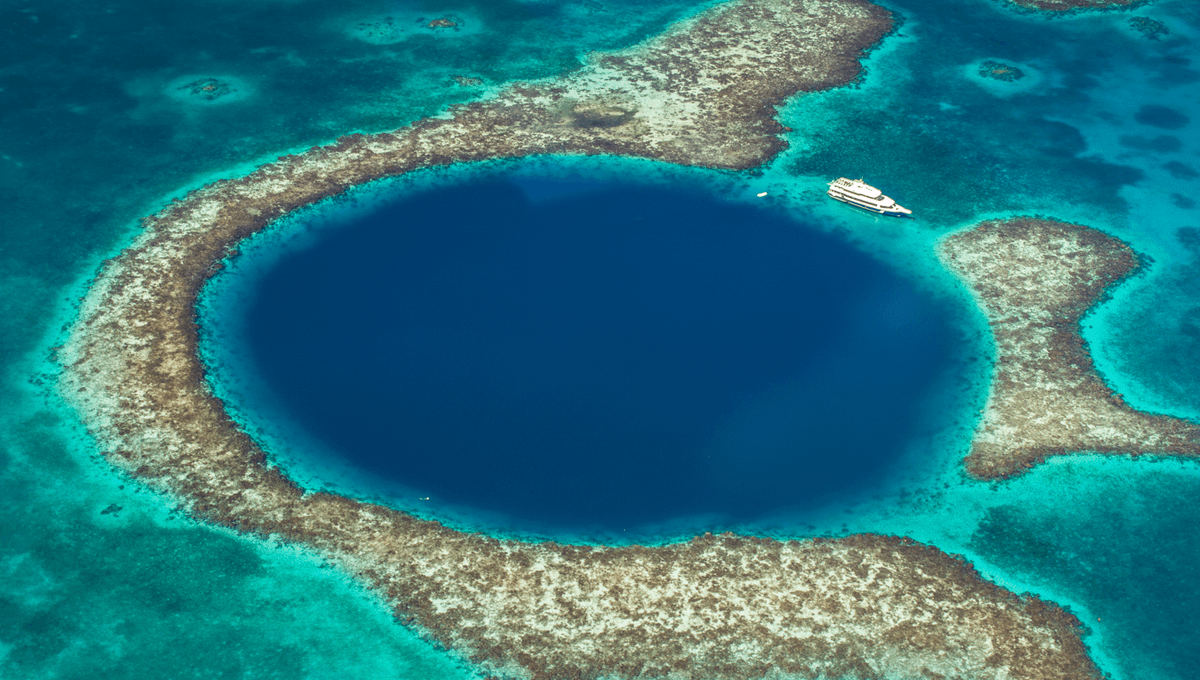
The history of the Great Blue Hole in the Caribbean is being revealed by a 30-meter (98-foot) sediment core taken from the depths of the marine sinkhole. Chronicling 5,700 years of natural history, the sample shows hurricanes are becoming increasingly common in this part of the southwestern Caribbean and a stormy future may lie ahead.
The Great Blue Hole is found in Lighthouse Reef Atoll in the Caribbean Sea around 80 kilometers (~50 miles) off the coast of Belize. Amid the atoll’s shallow turquoise waters, a huge circular opening suddenly plunges to a depth of 124 meters (407 feet), appearing as a vast, dark blue hole from the skies.
This marine sinkhole was formed during multiple glaciation periods when sea levels were significantly lower than they are today. During these times, the area was above sea level, allowing the formation of a limestone cave system. As the glacial periods ended and sea levels rose, these caves were submerged and eventually collapsed, creating the large, circular marine sinkhole we see today.
The bottom of this submerged pit has been gradually collecting sediment for the past 20,000 years, with each layer serving as an archive for extreme weather events in the region.
In the summer of 2022, scientists led by the Goethe University Frankfurt traveled to Belize and managed to obtain a 30-meter (98-foot) sediment core sample from the Great Blue Hole using a drilling platform that was shipped across the sea to the site.
By studying the different layers, the researchers can gain insights into ancient climatic and weather conditions over the past millennia. One particular feature they looked out for was distinct sedimentary event layers (called tempestites), which are caused by aggressive waves and storm surges transporting coarse particles from the atoll’s eastern reef edge into the marine sinkhole. If these appear in a layer, it’s a sure sign that a big storm rocked the region.
Using these markings, the team was able to identify a total of 574 storm events over the past 5,700 years.
“Due to the unique environmental conditions – including oxygen-free bottom water and several stratified water layers – fine marine sediments could settle largely undisturbed in the ‘Great Blue Hole.’ Inside the sediment core, they look a bit like tree rings, with the annual layers alternating in color between gray-green and light green depending on organic content,” Dr Dominik Schmitt, lead author of the study and researcher in the Biosedimentology Research Group at Goethe University Frankfurt, said in a statement.
“The tempestites stand out from the fair-weather gray-green sediments in terms of grain size, composition, and color, which ranges from beige to white,” says Schmitt.
The sediment cores also showed that the frequency of tropical storms and hurricanes in the southwestern Caribbean has gradually increased over the past six millennia. There’s an average of four to 16 tropical storms and hurricanes in this part of the world each century, yet there have already been nine storms in the past 20 years, suggesting this century will see a lot more storms than usual.
“Our results suggest that some 45 tropical storms and hurricanes could pass over this region in our century alone. This would far exceed the natural variability of the past millennia,” added Professor Eberhard Gischler, head of the Biosedimentology Research Group at Goethe University Frankfurt.
A key factor is the southward movement of a major weather belt, the Intertropical Convergence Zone, which helps determine where storms form and where they go. At the same time, rising sea temperatures are fueling more intense storms.
But this isn’t just a natural cycle. The study authors stress that the sharp increase in storm activity points directly to human-driven climate change, with the warming that began in the Industrial Age creating the perfect conditions for more frequent and powerful hurricanes.
The new study is published in the journal Science Advances.
Source Link: Scientists Drilled The Bottom Of Great Blue Hole And Uncovered 5,700 Years Of History